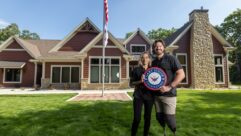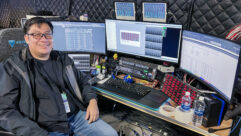
Installation Profile:
HGTV’s Dream Home 2005
Aug 1, 2005 12:00 PM,
By Linda Seid Frembess
Technologically advanced, whole-house control system does everything but the dishes.
For the past nine years, Home & Garden Television (HGTV) has designed and built a fully furnished home (dubbed the Dream Home) for the sole purpose of giving it away to one fortunate viewer. As this annual contest has gained popularity and larger sponsors, the folks at HGTV have made each year’s home bigger and more fantastic than the last.
For weeks leading up to the announcement of the winner, HGTV’s programming and commercial breaks tout the details and amenities of the year’s Dream Home. For 2005, the prize package included a home that is twice the square footage of the network’s previous largest home, a two-story dock house, a swimming pool, a THX-certified entertainment system, a GMC Envoy Denali, and $250,000 in cash. Whew. And if that weren’t enough, the 2005 Dream Home was billed as the most technologically advanced house ever built for the giveaway. The HomeLogic OneHome management and control system installed by IQ Home Systems links the home’s audio, video, HVAC, lighting, and security systems with the touch of a button.
This year’s HGTV Dream Home, the most technologically advanced of the nine homes built by the network to date, features a OneHome control system from HomeLogic for whole-house automation.
Photo courtesy HGTV.
FIRST, A TOUR
Before we get too far into the nuts and bolts, let’s take a look around this year’s giveaway. The 2005 Dream Home is a resort-style home located at The Reserve at Lake Tyler, near Tyler, Texas. The home has more than 5,000 square feet of living space, with special attention paid to the many activities to be enjoyed on a lake by the addition of a separate dock house. “The house design always takes into account … the building site,” says Jack Thomasson of Home Depot, the house planner who has worked on eight of the past nine HGTV homes. “The process begins in the spring of the prior year and is finished by September or October of the following year. We scout out a location and always use local architects and builders for the project. For the Lake Tyler house, I sat down with architect Antonio Flamenco [of InSite Architecture in Cypress, Texas] on a dirt pile at the site. He began sketching as we were talking — from there came the basic design of the house.”
In the center of the two-story main house is a Texas-inspired (i.e. big) living, dining, and cooking area called the great room. The open floor plan includes a 30ft.-tall limestone fireplace and a vaulted ceiling with exposed cedar trusses and beams. A breezeway connects the great room with the master suite, which includes its own private juice bar and computer nook. A screened porch with a hot tub and an outdoor fireplace separates the master bedroom from the main portion of the house. The house even has an elevator.

The e-library serves as a “study plus” that lets the whole family take advantage of high-speed Internet access and three web stations with Dell laptops.
Photo courtesy HGTV.
NOW, THE TECHNOLOGY
“Each year, I evaluate what people want out of a home based on my experiences when I travel the country,” says Thomasson. “Our attention to technology has evolved as the Internet and its uses have evolved. We’ve moved from having zero technology in the first house to pre-wiring for a network in a previous house, all the way to this year’s house with a full control system installed.”
The walkout level of the house is where the heart of the home’s technology resides. A 24’×19′ entertainment room features a 50in. RCA HDTV plasma TV with THX-certified Sonance speakers and an Onkyo receiver and DVD player. The room features exposed beams, recessed lighting, and two French doors leading onto a covered patio. An adjacent 10’×13′ exercise room that looks out over the patio has two treadmills, each with its own wall-mounted RCA LCD TV.
Also on the walkout level is the room known as the e-library. Billed by HGTV as a web-lover’s paradise, the 17’×13′ room is wired for high-speed Internet access and offers three web stations (desks outfitted with three Dell laptops), as well as built-in bookshelves for the traditional book lovers in the family.
The space was originally reserved as a utility room for the home’s lighting control system, but the design plan was changed once the build team realized that the lighting control system technology didn’t call for a massive physical hub. Instead only a portion of one wall of a small closet/wet bar beside the e-library was required to house the Electronic Design Technology (EDT) i-Line lighting control, HomeLogic OneHome system, GE Smart structured wiring, and GE Interlogix security system panels. The thought evolved from making the room a regular study into picking up the technology aspect and turning the room into a full-blown tech center for the household.
“As more family members are working from home, it’s nice to have a wired family area. We liked the idea of taking the PC and putting it in a community area for multi-generational use,” says Thomasson. “The e-library is visible from the entertainment room so parents can monitor the kids doing homework. So, instead of the kids separated in their own rooms, they can all be together doing homework in a centrally located, comfortable room.”
In spite of the e-library being a later addition to the house plans, builder Bill Mahaffey went above and beyond the call of duty to create a living space that fully uses the power of technology and shares the Internet experience with all members of the family. “We’ve taken a traditional study and turned it into so much more,” says Thomasson. “By adding all of the elements in today’s technology, it’s more like a ‘study plus’ that can be used by both adults and kids.”
Neatly tucked away in the e-library are the brains of the house. “We were searching for a whole-house control system and wanted to install a simple-to-use system with a short learning curve that was logical to operate,” says Thomasson. “And we wanted a system that could control lights, sound, and monitoring systems.”

The key to customizing the home’s technology lies in a portable touchscreen that serves as a wireless interface to the HomeLogic OneHome system.
Image courtesy HomeLogic.
Thomasson turned to local integrator IQ Home Systems in Longview, Texas, located about 45 minutes from Tyler. Marc Bally, president of IQ Home Systems, demonstrated the EDT i-Line lighting system to Thomasson, and he was sold. “The i-Line and OneHome systems fit the requirements. They were trying to build a house of the future, and we could offer leading-edge technology in a powerful system at an affordable price,” says Bally.
To the naked eye, the OneHome controller looks like a plain structured wire panel, but this one box contains several key elements: a wired and wireless home network, a distributed digital music system, and a fully integrated home control unit. The brain of the OneHome unit is an XP-embedded controller that ties various systems in the home together with a broadband computer network.
“HomeLogic has packaged together the key pieces of a complex home control system. The OneHome system ties together the subsystems without any custom programming, making a great choice for dealers like IQ Home Systems, that want to deliver robust, simple integrated solutions. The Dream Home team was able to choose the right gear for the project and integrate the various systems with one easy-to-use interface,” explains Joe Lautner, vice president of marketing and sales for HomeLogic.
The IP-based OneHome control system sits on the home’s computer network and uses the home’s infrastructure to provide a seamless integration. The Dream Home was pre-wired with Cat-5e cable to connect the system’s components via RJ-45 jacks to the RS-232, RS-485, and IP ports on the subsystems. “Since it is IP-based, the system can be configured over the Web, making it easy to support the installer,” says Lautner. “A homeowner can control the user interface from several Windows CE devices, like wireless and in-wall touchscreens and pocket PCs, as well as through any networked computer. The homeowner can manage their home from a laptop in the e-library or from outside the home with an Internet-capable PDA, computer, or telephone.”
Unlike other control programs, which often require extensive training to program, OneHome offers a simple, canned web interface that is the same on any control device. The concept is similar to that used with ATMs: A homeowner logging into the system from any location encounters the same interface every time. Lautner says, “OneHome is an automation system scheduling things like lights, climate, and irrigation automatically and is an easy-to-learn and user-friendly interface adding convenience to controlling home systems.”
After logging into the system, the home-owner can adjust individual settings or create customized “event maps.” For instance, the lights can be programmed to automatically turn on after dark when the homeowner opens the front door. Or, if the homeowners leave for the weekend, they can activate an “at-home lighting schedule” for safety. Other examples include smoke alarms that turn on lights and turn off the HVAC system or modes that turn on the lights to a particular mood setting and play music. OneHome also provides historical usage data for every system represented in the interface.
“When looking at the fully decorated house, you have to ask how someone will be able to take this house and make it their own,” says Thomasson. “I think the true customization is all in the programming of the system. … Offering programming options that are basic, but highly customized, will help the new homeowner feel at home in a short amount of time.”
The OneHome system uses a plug-and-play feature to pull in tabs for audio, video surveillance cameras, climate, lighting, messaging, and security. HomeLogic also offers irrigation controller and pool and spa tabs. For the Dream Home installation, Bally used the system to tie in the lighting, audio, and security systems. “The OneHome system really reduced the labor during the installation since it used the computer network of the GE Smart Structured wiring system and [let us] easily control the other systems using serial connections,” says Bally.
For the whole-house audio, Bally installed a GE Smart Audio system connected to the OneHome system to cover the great room, master bedroom, breezeway, and patio on the ground floor. In addition to being loaded with MP3 files, the system provides an Internet radio feed that can be routed anywhere in the house. GE-branded, flush-mounted ceiling speakers were installed all over the house, except in the great room, in order to blend in with the décor. SpeakerCraft AIM8 speakers where chosen for the great room because of it size. Bally also installed a GE NetworX security system compatible with the OneHome system.
For the intelligent lighting system, Bally provided i-Line lighting control by EDT, sister company to IQ Home Systems. The distributed lighting control system eliminated the need for a central controller. A 2’×2′ junction panel located in the closet/wet bar is the only visible part of the system. Each i-Line switch and device contains a small controller that handles all of the required processing. This effectively eliminates any single failure point, thereby vastly increasing the reliability of the system. Using a Cat-5e-based, daisy-chain connection, the i-Line system responds instantly to any command, no matter how large the system. A button press in the great room instantly turns on or off the boathouse lights 400ft. and more than 100 switches away. The i-Line system provides all lighting functions in the Dream Home and dock house, from basic on/off functions to complex dimmable scenes. This gives the Dream Home multiple moods, depending on the lighting design chosen. The i-Line system uses standard Cat-5e cables with standard RJ-45 connectors to connect its light switches. The main difference is that the system replaces standard switches with intelligent ones able to communicate with each other and other systems, like OneHome. The OneHome control system has been seamlessly integrated with i-Line to give the homeowner unlimited control over the lights from anywhere with the OneHome wireless touchscreen web tablet. Setup was a breeze since the system automatically recognized each i-Line switch. It was just a matter of plug and play, according to Bally. “The OneHome solution from HomeLogic has been a great addition to i-Line, providing an advanced user interface usually only found on systems 10 times the price,” he says.
For the monitoring system, two Panasonic pan/tilt KX-HCM10 network IP cameras were connected to the computer network, allowing installation of the cameras anywhere in the house or boathouse with a computer network port. Because it sits on the computer network, the monitoring system is expandable up to 256 IP cameras. Cameras can be used indoors and outdoors to monitor kids and visitors, or to work in conjunction with the security system for overall protection. Add a high-speed Internet connection, and the owner can view and control his house from anywhere in the world. “Due to the flexibility of the OneHome system, a homeowner can start out with just one component or they can choose to add on every single system tab we have to offer,” says Lautner. “OneHome uses low-level, two-way communications with its devices, so the possibilities are numerous.”

The OneHome system features tabs that allow homeowners to control audio, video surveillance cameras, climate, lighting, messaging, and security (pictured).
Image courtesy HomeLogic.
The most visible part of the system is the Dream Home’s portable touchscreen, the wireless interface to the HomeLogic OneHome system. The touchscreen is made by DT Research in Milpitas, Calif., a company that specializes in information access device platforms for integrators and developers. “HomeLogic recently launched its own line of in-wall touchscreens providing quick and responsive control and Internet surfing capabilities,” says Lautner.
Another unique aspect of the system is the amount of control given to homeowners, compared with similar residential control systems on the market. Lautner explains: “OneHome puts the climate and lighting scheduler in the hands of the homeowners. With other systems, you would need someone to come out and reprogram your schedule for you. Our system is intuitive, and people find it easy to use with little training. Folks interested in the system range from tech-savvy 30-somethings to empty nesters.”
According to Lautner, HomeLogic has shipped approximately 300 OneHome systems across the country. For servicing, a technician needs to visit onsite only if the OneHome controller needs to be physically accessed (in the case of a parts failure, etc.). Otherwise, service issues can be resolved remotely. For an optional monthly fee of $24.95, a homeowner gets a remote connection service from HomeLogic that includes software upgrades, similar to the service offered by Tivo.
“I like how the house is modern, but doesn’t look futuristic when you walk in the door. The technology is very well integrated; you only see it if you’re looking for it,” says Thomasson. “It was great working with vendors who understood technology.”
Earlier this year, the Dream Home was awarded to west Chicago native Don Cruz and his family. Cruz’s name was chosen from a record 39.1 million entries in the 2005 sweepstakes.
For More Information
EDT
www.edt.biz
GE Security
www.geindustrial.com
HomeLogic
www.homelogic.com
IQ Home Systems
www.iq-is.com
Onkyo
www.onkyo.com
RCA
www.rca.com
Sonance
www.sonance.com
SpeakerCraft
www.speakercraft.com
Linda Seid Frembesdreamed of winning the HGTV house, moving to Texas, and working “just for fun.” There’s always next year…










